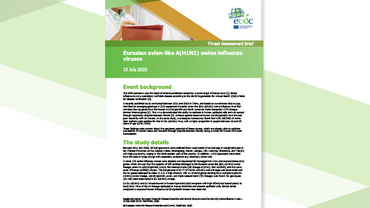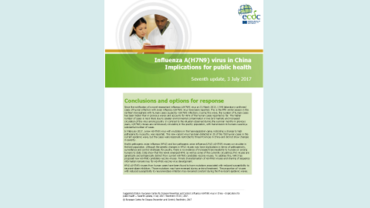Situation overview: highly pathogenic avian influenza virus A of H5 type, 2 December 2015
Highly pathogenic avian influenza (HPAI) of the subtype A(H5N1) and A(H5N2) have been detected in birds at a backyard farm in the Dordogne region of France. This risk assessment looks at the risks of transmission in the EU/EEA and the options for response in connection with this localised outbreak.
Executive Summary
Following the detection of highly pathogenic avian influenza (HPAI) of the subtypes A(H5N1) and A(H5N2) in birds in a backyard farm and commercial farms, respectively, in France, ECDC has issued a new rapid risk assessment. Whenever avian influenza viruses are circulating in poultry, sporadic human infections are possible in people exposed to infected poultry or contaminated environments.
However, the assessment concludes that the risk of transmission to the general public in EU/EEA countries is extremely low. In addition, although an introduction into other EU countries with contaminated goods cannot be ruled out, the risk of these viruses spreading is considered to be low.
On 25 November 2015, the French authorities notified the EU about an outbreak of HPAI A(H5N1) in a backyard holding in Dordogne. Following abnormal mortality in the holding, the virus was confirmed as HPAI A(H5N1) by the French Agency for Food, Environmental and Occupational Health & Safety (ANSES). On 30 November and 1 December, French authorities also reported two poultry farms in Dordogne were affected by A(H5) viruses, an HPAI A(H5) with pending N typing results in a commercial duck farm and an HPAI A(H5N2) in a goose farm.
The A(H5N1) virus identified in the French backyard farm does not appear to be related to any of the currently circulating highly pathogenic viruses in Asia, but rather has evolved from previously circulating low pathogenic A(H5N1) viruses in Europe. There have been no human HPAI A(H5N1) cases identified in Europe although there have been detection amongst birds elsewhere in Europe. Furthermore, no bird-to-human infections have been reported from low pathogenic A(H5N1) viruses. No human cases related to HPAI A(H5N2) have been observed worldwide.
Whenever avian influenza viruses are circulating in poultry, sporadic infections or small clusters of human cases are possible in people exposed to infected poultry or contaminated environments, especially in households and at live bird markets. Sustained human-to-human transmission of influenza A(H5N1) virus and its highly pathogenic reassortants have never been observed.
Animal and public health authorities should be prepared for a possible introduction of HPAI A(H5N1) or A(H5N2) into other European countries although the risk is considered low.
The risk of a foodborne transmission (e.g. eggs and meat) is considered extremely low according to EFSA.







